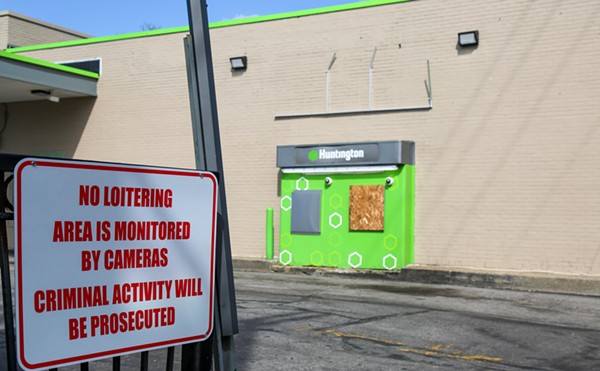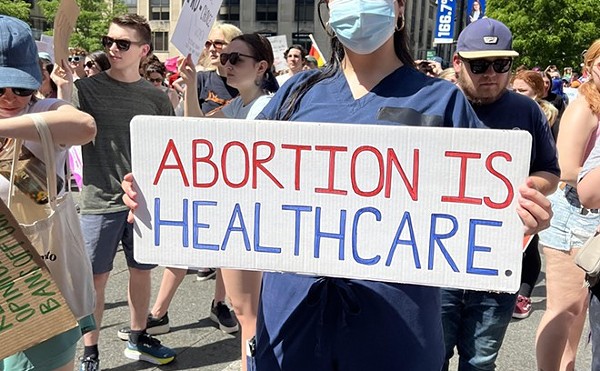The plane crosses the target and Kujda guns the engine. The nose pops back toward the sky. A small metal hook on the plane's tail catches a rope strung between two rickety poles. At the end of the rope is a 250-foot banner that reads "Christie's Cabaret The party starts here!!" Kujda roars off, and the banner twists and rises into the air.
They're known as "banner humpers," and they use the sky to pull flying advertisements. Though Christie's Cabaret gets regular shifts over downtown and the highways, the real money used to be made pulling ads over the captive crowds at sporting events, such as Browns and Indians games. Then came September 11. The Federal Aviation Administration temporarily banned flying above packed stadiums. In February, Congress made it permanent.
The aerial advertising industry was never big to start with, and the ban has almost killed it. Five companies used to tow banners around Cleveland. Today, John Kujda's employer, Air America, is the only one left.
The NFL, NCAA, and Major League Baseball say the aerial ads posed a major terrorism risk. But pilots contend the leagues had a less noble motive: They wanted to kill off advertising rivals. "Little guys like us have been put out by the big-money interests," says Air America owner Jim Miller.
Miller first towed banners when he was 13. His father owned an air advertising company, and Miller founded his own in 1986, when he was 21. At its peak, Air America had 21 pilots and 11 planes flying from the Rose Bowl to the Daytona 500. In a world awash with ads, novelty made him successful. "Aerial advertising is very effective because it grabs people's attention and because you don't see it every day," says Miller.
It's also cheap. Air America charges $300 an hour -- a pittance compared to the cost of advertising in official programs or on the Browns' scoreboard. Long before September 11, sports leagues were lobbying the FAA to outlaw aerial advertisers. There wasn't yet a concern for terrorism, but the leagues were worried about safety.
In 2001, the NCAA ran a story about aerial advertisers in its biweekly newsletter for administrators. Titled "Shoo, fly," the article posed unlikely scenarios: "What if there were 25, 50, or 100 banners being dragged over the stadium during the course of a game? What if the drone of those planes became so loud that it drowned out even the marching bands? What if two of those planes collided? What would fans think of that?"
But since September 11, the leagues have complained primarily about terrorism. "It has nothing to do with revenues from advertising," says Brian McCarthy, spokesman for the NFL. "It has everything to do with fan safety."
Banner humpers aren't buying it. Their planes are too small and too slow to threaten anybody but the pilots, they argue. "If I tried to attack Browns Stadium with my plane, I'd hit the field like a lawn dart," Miller says.
If a terrorist skimped on fuel, he could load a plane with maybe 400 pounds of explosives. But why bother? It's an arduous process to hook a banner onto a plane, requiring considerable skill. "This is not just some joe-blow pilot who can do this," says Jim Butler, who owns Aerial Sign Company in Florida, the nation's largest aerial advertising company. "It's on a smaller scale, but the physics are just like landing an airplane on an aircraft carrier."
Besides, only a few hundred feet from Browns Stadium sits Burke Lakefront Airport, where Gulfstream jets -- capable of hauling up to 5,000 pounds -- take off and land with impunity. So why worry about rinky-dink crop-dusters?
Safety experts say pilots underestimate terrorists' resourcefulness. "If the question is whether the terrorists are nimble enough and capable of mastering this business of getting the banners, they certainly showed a lot of skill on September 11," says Arnold Barnett, an MIT professor and consultant to the Transportation Security Administration.
But the wording of the ban also raises suspicion, pilots say. Immediately after September 11, flights of any kind were banned within 3,000 feet of any large, open-air gathering. The law passed this year by Congress narrowed the language considerably, banning flights over any event with a "capacity of 30,000 or more people in which a Major League Baseball, National Football League or NCAA Division I football or major motor speedway event is occurring." What about 30,000 people watching a Metallica show? Or 50,000 attending a summer festival? Aerial advertisers aren't banned from flying over those events. "This isn't about safety," says Miller. "It's about who has the bigger lobbyists. The NFL, NCAA, and NASCAR all spend a lot more money on lobbyists than your community arts festival."
Legitimate or not, the ban has crushed the banner humpers. Before it, there were 400 aerial advertisers in the country. Today there are 125. The national association went broke lobbying Congress to drop the ban. There's no money left to fight a new front on free-speech grounds. Four Cleveland companies closed. Air America laid off 18 people and sold seven planes. Banned from stadiums, the only remaining venue is to tow banners over highways during rush hour.
"I'm putting a lot more hours on my planes, and I'm making a lot less money per hour," Miller says. "It's sloppy seconds. I just hope we can hang on."














